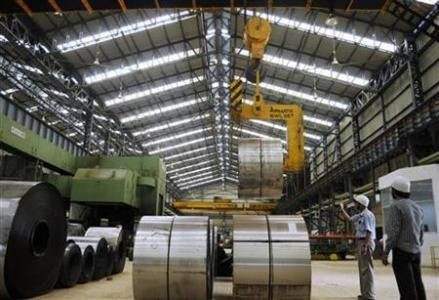India's Economic Growth Weakest in 3 Years; Q3 GDP Grows at 6.1 Percent

India's economic growth slowed to its weakest annual pace in almost three years in the three months to December, as high interest rates and rising input costs constrained investment and manufacturing.
Employees work inside a steel factory in Agartala.
GDP rose 6.1 percent in October to December compared with a year earlier, a lower-than-expected increase, figures from the statistics office showed.
That marked a sharp pullback from 6.9 percent growth in July to September and was the seventh successive quarterly slowdown, providing a gloomy backdrop for a Reserve Bank policy meeting and federal budget, both due in just over two weeks.
The median forecast of economists in a Reuters poll was for GDP to rise 6.4 percent. The outcome of 6.1 percent was the weakest in 11 quarters.
Moderation in the manufacturing sector was likely the starkest as higher input prices and a sharp jump in borrowing costs depressed output, said Radhika Rao, an economist at Forecast in Singapore.
The ball is in the government's court now to kick start policy reforms.
The yield on India's benchmark 10-year government bond rose 1 basis point to 8.2 percent after the data. The BSE Sensex and the rupee were little changed.
Growth in Asian economies is expected to slow down further in the first quarter of calendar 2012, suggesting that India may feel more economic pain in the months ahead. China's January to March growth is forecast to drop for the fifth straight quarter.
Unlike most other Asian economies, India has struggled to beat down inflation, so the central bank has kept interest rates at a three-year high since October while policymakers elsewhere in the region were cutting rates.
India has also suffered a longer-term steady decline in growth owing to a lack of economic reform that resulted in weak investment. Average growth of 9.5 percent in the three years to 2007/08 slowed to 8.4 percent in the past two fiscal years and is widely expected to ease to about 7 percent in the current financial year ending March.
The Reserve Bank of India, which has asked the government to cut fiscal deficits to help rein in inflation, signalled last month it was ready to cut interest rates to try to stimulate the economy.
Indian consumer prices rose 7.65 percent in the year to January. That was higher than wholesale inflation but suggested some moderation in price pressures which could give the central bank room to cut interest rates.
Still, rising oil prices are emerging as a concern for the RBI while Finance Minister Pranab Mukherjee, faced with a burgeoning fiscal deficit due in part to a huge subsidy bill, is not in a strong position to announce major stimulus measures.
The RBI will release the outcome of its policy review on March 15, a day before the government announces it budget.
Economists point to government policy paralysis, stubborn inflation and high interest rates as major reasons for the slowdown in investment.
Wednesday's data showed manufacturing barely grew at just 0.4 percent in the December quarter from a year earlier. Annual car sales are likely to drop for the first time since 2002 in the year to March after January sales fell short of expectations.
The farm sector grew 2.7 percent from a year earlier, the data showed.
Economists said growth may languish below 7 percent in coming quarters as well, particularly if crude oil prices stay high. India imports nearly 80 percent of its oil needs, and oil accounts for nearly a third of the country's imports.
The RBI ran a 20-month interest rate tightening cycle until October to try to rein in inflation. Economists generally expect the RBI to cut its main policy rate by 100 basis points in 2012 from the current 8.5 percent.
© Copyright Thomson Reuters 2024. All rights reserved.





















